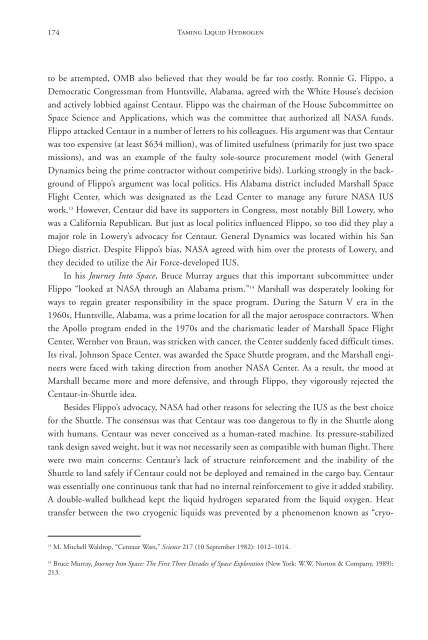Taming Liquid Hydrogen - NASA's History Office
Taming Liquid Hydrogen - NASA's History Office
Taming Liquid Hydrogen - NASA's History Office
Create successful ePaper yourself
Turn your PDF publications into a flip-book with our unique Google optimized e-Paper software.
174<br />
<strong>Taming</strong> <strong>Liquid</strong> <strong>Hydrogen</strong><br />
to be attempted, OMB also believed that they would be far too costly. Ronnie G. Flippo, a<br />
Democratic Congressman from Huntsville, Alabama, agreed with the White House’s decision<br />
and actively lobbied against Centaur. Flippo was the chairman of the House Subcommittee on<br />
Space Science and Applications, which was the committee that authorized all NASA funds.<br />
Flippo attacked Centaur in a number of letters to his colleagues. His argument was that Centaur<br />
was too expensive (at least $634 million), was of limited usefulness (primarily for just two space<br />
missions), and was an example of the faulty sole-source procurement model (with General<br />
Dynamics being the prime contractor without competitive bids). Lurking strongly in the background<br />
of Flippo’s argument was local politics. His Alabama district included Marshall Space<br />
Flight Center, which was designated as the Lead Center to manage any future NASA IUS<br />
work. 13 However, Centaur did have its supporters in Congress, most notably Bill Lowery, who<br />
was a California Republican. But just as local politics influenced Flippo, so too did they play a<br />
major role in Lowery’s advocacy for Centaur. General Dynamics was located within his San<br />
Diego district. Despite Flippo’s bias, NASA agreed with him over the protests of Lowery, and<br />
they decided to utilize the Air Force-developed IUS.<br />
In his Journey Into Space, Bruce Murray argues that this important subcommittee under<br />
Flippo “looked at NASA through an Alabama prism.” 14 Marshall was desperately looking for<br />
ways to regain greater responsibility in the space program. During the Saturn V era in the<br />
1960s, Huntsville, Alabama, was a prime location for all the major aerospace contractors. When<br />
the Apollo program ended in the 1970s and the charismatic leader of Marshall Space Flight<br />
Center, Wernher von Braun, was stricken with cancer, the Center suddenly faced difficult times.<br />
Its rival, Johnson Space Center, was awarded the Space Shuttle program, and the Marshall engineers<br />
were faced with taking direction from another NASA Center. As a result, the mood at<br />
Marshall became more and more defensive, and through Flippo, they vigorously rejected the<br />
Centaur-in-Shuttle idea.<br />
Besides Flippo’s advocacy, NASA had other reasons for selecting the IUS as the best choice<br />
for the Shuttle. The consensus was that Centaur was too dangerous to fly in the Shuttle along<br />
with humans. Centaur was never conceived as a human-rated machine. Its pressure-stabilized<br />
tank design saved weight, but it was not necessarily seen as compatible with human flight. There<br />
were two main concerns: Centaur’s lack of structure reinforcement and the inability of the<br />
Shuttle to land safely if Centaur could not be deployed and remained in the cargo bay. Centaur<br />
was essentially one continuous tank that had no internal reinforcement to give it added stability.<br />
A double-walled bulkhead kept the liquid hydrogen separated from the liquid oxygen. Heat<br />
transfer between the two cryogenic liquids was prevented by a phenomenon known as “cryo-<br />
13 M. Mitchell Waldrop, “Centaur Wars,” Science 217 (10 September 1982): 1012–1014.<br />
14 Bruce Murray, Journey Into Space: The First Three Decades of Space Exploration (New York: W.W. Norton & Company, 1989):<br />
213.

















